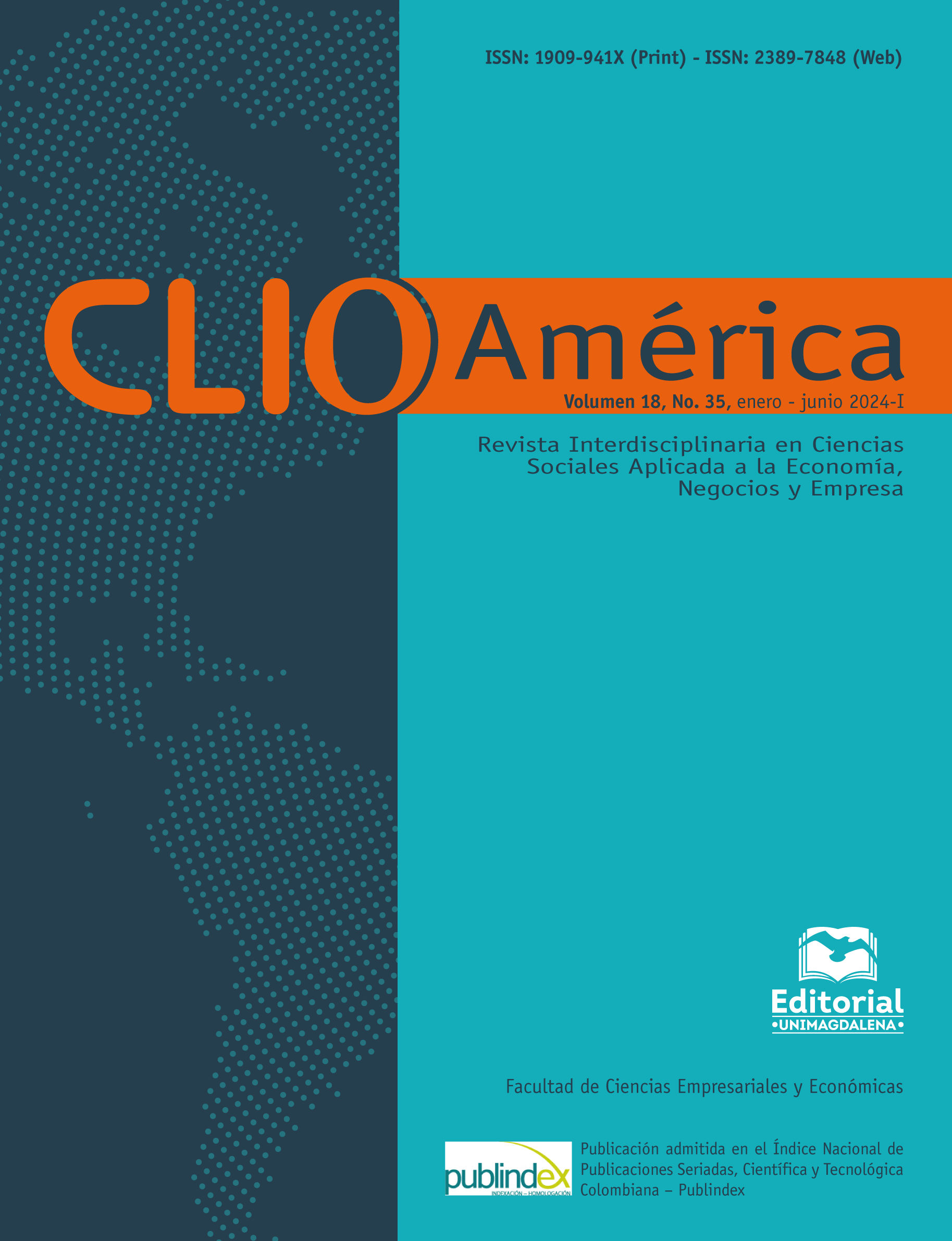Aproximación teórico-conceptual del marketing inclusivo: una perspectiva desde las discapacidades sensoriales
Main Article Content
Abstract
Downloads
Article Details

This work is licensed under a Creative Commons Attribution-NonCommercial-ShareAlike 4.0 International License.
This journal provides an open access to its content, based on the principle of offering the public free access to research, helping to increase global knowledge exchange. Likewise, the printed version is freely accessible and has no associated costs per publication.
References
American Marketing Association - AMA. (2017). What is Marketing? — The Definition of Marketing — AMA. https://www.ama.org/the-definition-of-marketing-what-is-marketing/
Anderson, L., Ostrom, A. L., Corus, C., Fisk, R. P., Gallan, A. S., Giraldo, M., Mende, M., Mulder, M., Rayburn, S. W., Rosenbaum, M. S., Shirahada, K. & Williams, J. D. (2013). Transformative service research: An agenda for the future. Journal of Business Research, 66(8), 1203–1210. https://doi.org/10.1016/J.JBUSRES.2012.08.013
Anker, T. B., Gordon, R. & Zainuddin, N. (2022). Consumer-dominant social marketing: a definition and explication. European Journal of Marketing, 56(1), 159–183. https://doi.org/10.1108/EJM-08-2020-0618
Arias, F. (2012). El Proyecto de Investigación (6th ed.). Editorial Episteme.
Asociación de Programas de Mercadeo. – ASPROMER. (2022). https://aspromer.com/nosotros/
Azmat, F., Ferdous, A. S. & Couchman, P. (2015). Understanding the Dynamics between Social Entrepreneurship and Inclusive Growth in Subsistence Marketplaces. Https://Doi.Org/10.1509/Jppm.14.150, 34(2), 252–271. https://doi.org/10.1509/JPPM.14.150
Azmat, F., Fujimoto, Y. & Rentschler, R. (2014). Exploring cultural inclusion: Perspectives from a community arts organisation. Http://Dx.Doi.Org/10.1177/0312896214525180, 40(2), 375–396. https://doi.org/10.1177/0312896214525180
Campbell, J. E. (2005). Outing PlanetOut: surveillance, gay marketing and internet affinity portals. Http://Dx.Doi.Org/10.1177/1461444805056011, 7(5), 663–683. https://doi.org/10.1177/1461444805056011
Casado, L. & Arrese, Á. (2022) The Era of Authentically Inclusive Marketing. Nuevas Tendencias, 7(108), 24–29. https://doi.org/10.2/JQUERY.MIN.JS
Duque-Hurtado, P., Samboni-Rodriguez, V., Castro-Garcia, M., Montoya-Restrepo, L. A. & Montoya-Restrepo, I. A. (2020). Neuromarketing: seu estado atual e perspectivas de pesquisa. Estudios Gerenciales, 36(157), 525-539.
Elizalde, M. (2021, July 5). Marketing Social e inclusivo | Revista NEO. https://www.revistaneo.com/index.php/articles/2021/07/05/marketing-social-e-inclusivo
Escuela Superior de Administración y Dirección de Empresas – ESADE. (2015). El Mercado Potencial de las Personas con Discapacidad en España. Grupo Editorial Cinca, S.A.
French, J. (2011). Why nudging is not enough. Journal of Social Marketing, 1(2), 154–162. https://doi.org/10.1108/20426761111141896/FULL/XML
George, G., Mcgahan, A. M. & Prabhu, J. (2012). Innovation for Inclusive Growth: Towards a Theoretical Framework and a Research Agenda. Journal of Management Studies, 49(4), 661–683. https://doi.org/10.1111/J.1467-6486.2012.01048.X
Gong, Z. H. (2020). Crafting Mixed Sexual Advertisements for Mainstream Media: Examining the Impact of Homosexual and Heterosexual Imagery Inclusion on Advertising Effectiveness. Journal of Homosexuality, 67(7), 916–939. https://doi.org/10.1080/00918369.2018.1564005
Gurrieri, L. & Finn, F. (2023). Gender transformative advertising pedagogy: promoting gender justice through marketing education. Journal of Marketing Management, 39(1–2), 108–133. https://doi.org/10.1080/0267257X.2022.2157461
Gurrieri, L., Gordon, R., Barraket, J., Joyce, A. & Green, C. (2018). Social marketing and social movements: creating inclusive social change coalitions. Journal of Social Marketing, 8(4), 354–377. https://doi.org/10.1108/JSOCM-12-2016-0078
Hasan, M. M., Yajuan, L. & Khan, S. (2020). Promoting China’s Inclusive Finance Through Digital Financial Services. Https://Doi.Org/10.1177/0972150919895348, 23(4), 984–1006. https://doi.org/10.1177/0972150919895348
Hasan, M., Noor, T., Gao, J., Usman, M. & Abedin, M. Z. (2023). Rural Consumers’ Financial Literacy and Access to FinTech Services. Journal of the Knowledge Economy, 14(2), 780–804. https://doi.org/10.1007/S13132-022-00936-9
Hernández-Sampieri, R. & Mendoza, C. (2018). Metodología de la investigación: Las rutas cuantitativa, cualitativa y mixta. McGraw Hill.
Ireland, J. (2008). Lessons for successful BOP marketing from Caracas’ slums. Journal of Consumer Marketing, 25(7), 430–438. https://doi.org/10.1108/07363760810915644
Kotler, P. & Armstrong. (2013a). Fundamentos de marketing. In Fundamentos de marketing (p. 5). Pearson Education, Inc.
Kotler, P. & Armstrong, G. (2013b). Fundamentos de Marketing (11th ed.). Pearson Education.
Kotler, P. Kartajaya, H., & Setiawan, I. (2010). Marketing 3.0.
Kotler, P. & Roberto, E. (1991). Marketing social: Estrategias para cambiar la conducta pública. Díaz de Santos.
Kotler, Philip. & Roberto, Ned. (1992). Marketing social : estrategias para cambiar la conducta pública. https://books.google.com/books/about/Marketing_social.html?hl=es&id=vMRDpBfowEMC
Licsandru, T. C. & Cui, C. C. (2018). Subjective social inclusion: A conceptual critique for socially inclusive marketing. Journal of Business Research, 82, 330–339. https://doi.org/10.1016/j.jbusres.2017.08.036
Mejía-Bohórquez, E., Fernando Jaramillo López, J., Restrepo Aristizábal, S., Gutiérrez Posada, V., Mauricio Maya Cadavid, L. & Pontificia Bolivariana, U. (2014). Diseño inclusivo: Comunicación para personas con discapacidad visual aplicada al punto de venta * Inclusive design: Communication for people with visual disabilities apply to the point of purchase. Revista Publicuidad |, 3, 102–141. https://doi.org/10.18566/publicuidad.v03n01.a06
Prahalad, C. K., Di Benedetto, A. & Nakata, C. (2012). Bottom of the Pyramid as a Source of Breakthrough Innovations. Journal of Product Innovation Management, 29(1), 6–12. https://doi.org/10.1111/J.1540-5885.2011.00874.X
Prahalad, C. K. & Ramaswamy, V. (2004). Co-creation experiences: The next practice in value creation. Journal of Interactive Marketing, 18(3), 5–14. https://doi.org/10.1002/DIR.20015
Robledo, S., Grisales Aguirre, A. M., Hughes, M. & Eggers, F. (2023). “Hasta la vista, baby”–will machine learning terminate human literature reviews in entrepreneurship?. Journal of Small Business Management, 61(3), 1314-1343.
Robledo, S., Osorio, G. & Lopez, C. (2014). Networking en pequeña empresa: una revisión bibliográfica utilizando la teoria de grafos. Revista vínculos, 11(2), 6-16.
Spotswood, F., Tapp, A., French, J. & Stead, M. (2012). Some reasonable but uncomfortable questions about social marketing. Journal of Social Marketing, 2(3), 163–175. https://doi.org/10.1108/20426761211265168/FULL/XML
Stanton, W., Etzel, M. & Walker, B. (2007). Fundamentos de Marketing (14th ed.). McGraw-Hill Interamericana.
Tidd, J. & Bessant, J. (2015). Innovation and Entrepreneurship, Chapter 1 - The Innovation Imperative. Innovation and Entrepreneurship, 3–44. https://www.researchgate.net/publication/285734411_Innovation_and_Entrepreneurship
United Nations. – UNESCO (2008). Convention on the Rights of Persons and Facultative Protocol https://www.un.org/disabilities/documents/convention/convoptprot-s.pdf
United Nations. – UNESCO (2022). People with Disabilities. Retrieved from https://www.un.org/development/desa/disabilities-es/algunos-datos-sobre-las-personas-con-discapacidad.html#:~:text=Alrededor%20del%2010%25%20de%20la,de%20la%20Salud%20(OMS).
Vargo, S. & Lusch, R. (2004). Evolving to a New Dominant Logic for Marketing. Journal of Marketing, 68, 1–17.
World Health Organization – WHO (2021) Disability. https://www.who.int/es/news-room/fact-sheets/detail/disability-and-health
World Intellectual Property Organization, Dutta, S., Lanvin, B., Rivera León, L. & Wunsch-Vincent, S. (2022). Global Innovation Index 2022, 15th Edition. Global Innovation Index 2022 : What Is the Future of Innovation-Driven Growth?, 42–55. https://doi.org/10.34667/TIND.46596
Zuluaga, M., Robledo, S., Zuluaga, G. A. O., Yathe, L., Gonzalez, D. & Taborda, G. (2016). Metabolómica y Pesticidas: Revisión sistemática de literatura usando teoría de grafos para el análisis de referencias. Nova, 14(25), 121-138.

